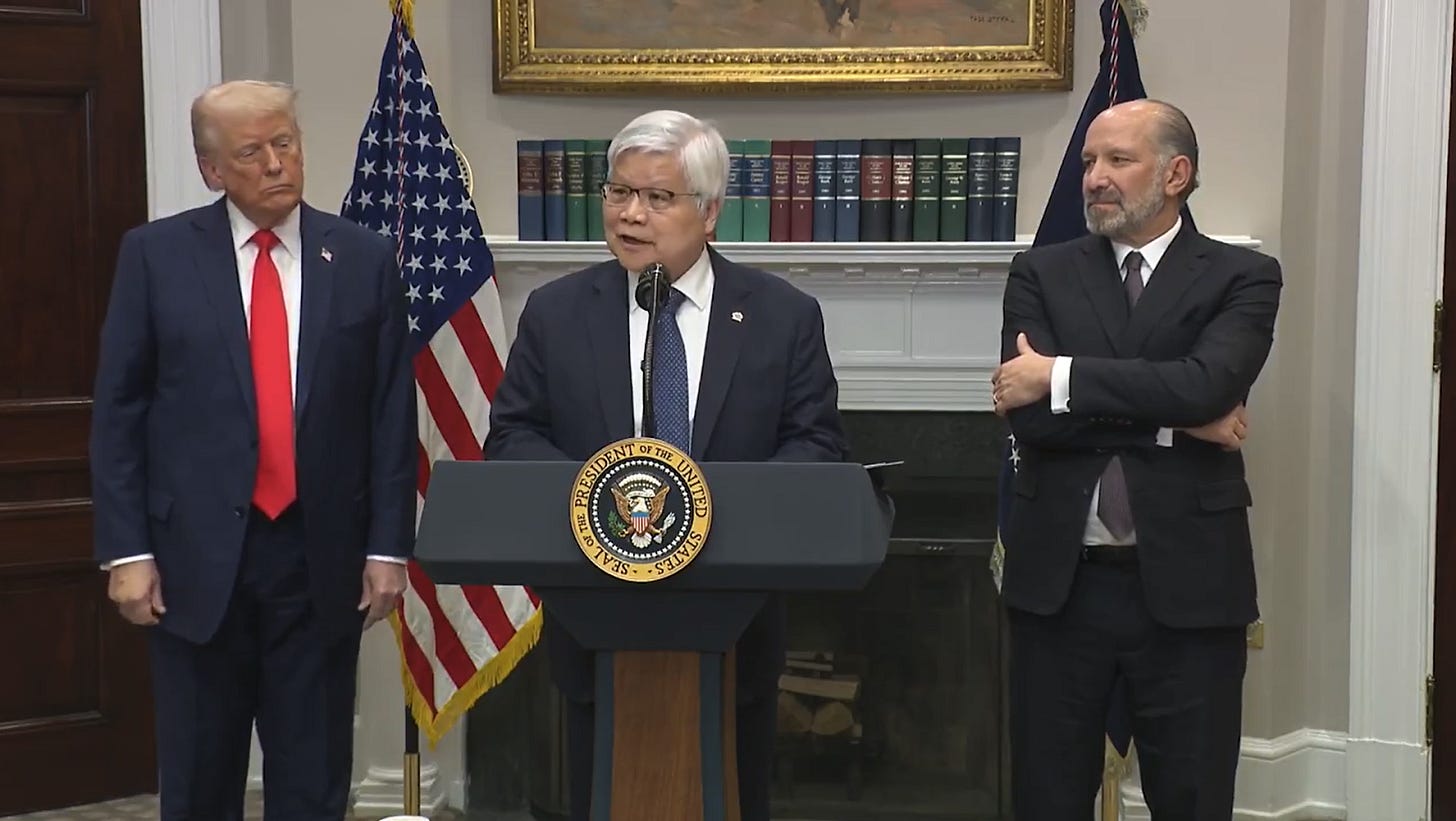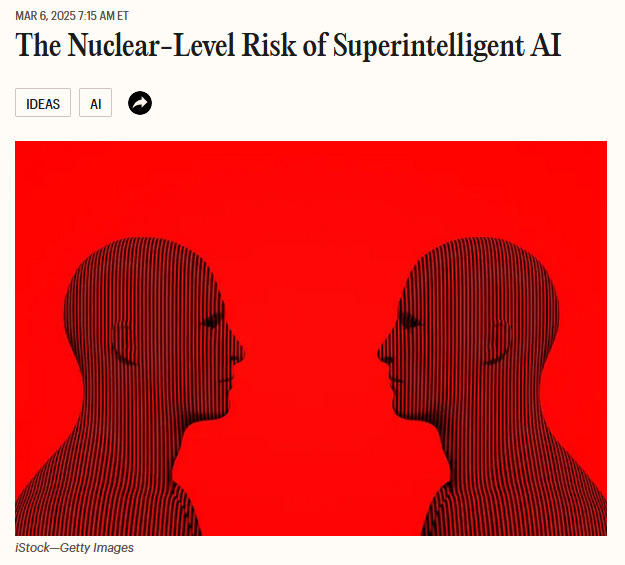Welcome to AI Policy Weekly, a newsletter from the Center for AI Policy (CAIP). Each issue explores three important developments in AI, curated specifically for U.S. AI policy professionals.
Top AI Chip Manufacturer Invests $100 Billion in New U.S. Factories
The Taiwan Semiconductor Manufacturing Company (TSMC) takes all of NVIDIA’s top AI chip designs—from Ampere to Hopper to Blackwell—and physically manufactures the corresponding chips at semiconductor fabrication plants, also known as “fabs.”
“We’re fabbing at TSMC because it’s the world’s best,” said NVIDIA CEO Jensen Huang last year. “And it’s the world’s best not by a small margin, it’s the world’s best by an incredible margin.”
At the White House on Monday, TSMC CEO C.C. Wei, U.S. President Donald Trump, Commerce Secretary Howard Lutnick, and AI Czar David Sacks announced a new plan for TSMC to invest $100 billion in the United States.
TSMC had already planned to spend $65 billion to build three new fabs in Phoenix, AZ.
Thus, after Monday’s announcement, TSMC’s total planned U.S. investment is $165 billion.
According to TSMC, the new $100 billion will go towards “three new fabrication plants, two advanced packaging facilities and a major R&D team center, solidifying this project as the largest single foreign direct investment in U.S. history.”
TSMC will build these new facilities in Arizona, so Arizona will end up housing at least six different TSMC fabs.
TSMC’s first Arizona investment came during Trump’s first term, with $12 billion announced in May 2020 to build a fab.
In December 2022, TSMC declared intentions to build a second fab in Phoenix, bringing the total investment to $40 billion.
The next big increase came in April 2024, when TSMC signed an agreement with the Commerce Department to receive up to $6.6 billion in CHIPS Act funding. It also announced intentions to build a third Phoenix fab, raising the total project cost to $65 billion.
TSMC has already received $1.5 billion of its promised CHIPS Act funds. However, the remaining $5.1 billion have a somewhat uncertain future, as President Trump recently called on Congress to “get rid of the CHIPS Act and whatever’s left over.”
Currently, over 80% of Taiwan Semiconductor Manufacturing Company fabs are in, well, Taiwan.
Meanwhile, China-Taiwan relations are tense, with Chinese Premier Li Qiang recently stating that China “will firmly advance the cause of China’s reunification” with Taiwan.
If future geopolitical events forced NVIDIA to switch from TSMC to a new manufacturer like Samsung, the adjustment would be difficult.
“Picking up and moving to a new supplier would be a monumental task,” said SemiAnalysis Chief Analyst Dylan Patel. “The capacity would take many years to rebuild.”
The impact would extend beyond NVIDIA, because TSMC also fabricates cutting-edge AI chips for NVIDIA competitors like AMD, Intel, and Cerebras.
In sum, dependence on Taiwanese fabs constitutes an Achilles heel in America’s AI chip industry. TSMC’s $165 billion investment offers a path to greater resilience.

Paper Proposes Mutual Assured AI Malfunction (MAIM) Deterrence Regime
Former Google CEO Eric Schmidt, Scale AI CEO Alexandr Wang, and Center for AI Safety Director Dan Hendrycks have co-authored a new paper called “Superintelligence Strategy.”
By superintelligence, they mean “AI vastly better than humans at nearly all cognitive tasks.” This is a theoretical form of AI that may remain elusive for decades, or may be achieved in the next few years.
“Destabilizing AI developments could rupture the balance of power and raise the odds of great-power conflict, while widespread proliferation of capable AI hackers and virologists would lower barriers for rogue actors to cause catastrophe,” the paper begins.
The authors describe how they see the strategic picture for AI superpowers like the United States and China.
The first pillar is deterrence. Similar to the concept of mutual assured destruction (MAD) that governs nuclear weapons, the authors introduce the concept of “mutual assured AI malfunction”—MAIM—an acronym as bleak as its nuclear predecessor.
MAIM warns that nations will not allow rivals to develop AI capabilities that could create a strategic monopoly or pose an existential threat, such as an “AI Manhattan Project.” To counter such projects, nations might deploy espionage, covert sabotage, overt cyberattacks, and potentially even kinetic (physical) attacks on datacenters.
The paper’s second pillar is nonproliferation, which refers to coordinated efforts to prevent advanced AI capabilities and resources from falling into the hands of rogue actors or terrorists.
Achieving nonproliferation would involve improving the security of computational resources, sensitive information, and AI models themselves, so that unauthorized parties cannot misuse AI capabilities.
The third and final pillar is competitiveness, a nation’s ability to remain strong and influential in the age of AI.
To promote competitiveness, nations can integrate AI into military operations, manufacture AI chips, facilitate immigration for AI scientists, use AI-powered event forecasting to improve decision-making, try to align individual AI agents and large collections of AI agents, and more.
“Superintelligence Strategy” articulates many points, plenty of which diverge from the Center for AI Policy’s perspective. But it is an ambitious effort to prepare for the imminent geopolitical hazards of highly capable AI. It’s worth a read.

Speedy Robot Dog Seems Poised to Run a Sub-Six-Minute Mile
“Spot” is the name of Boston Dynamics’ four-legged robot, which looks a bit like a dog. It has already seen real world use at BP oil rigs, Michelin tire facilities, and even Purina dog food factories (somewhat suspiciously).
Now, scientists have tripled the running speed of Spot using AI techniques, according to new research highlighted in IEEE Spectrum.
The Robotics and AI (RAI) Institute pushed Spot to reach a blistering pace of 5.2 meters per second (11.6 miles per hour), far exceeding its factory top speed of 1.6 meters per second.
At this new pace, Spot could theoretically complete a mile in under 5.5 minutes. For reference, the world’s fastest humans can run a mile in a little under 4 minutes.
Of course, whether the robot could actually sustain this impressive pace for a full mile remains to be seen. Speed is one thing; endurance is another.
Importantly, Spot’s speed still has room for improvement.
“If we had beefier batteries on there, we could have run faster,” said Farbod Farshidian, a roboticist at the RAI Institute. “And if you model that phenomena as well in our simulator, I’m sure that we can push this farther.”
At this rate, man’s robotic best friend might soon leave top runners in the dust.

CAIP News
Claudia Wilson published a blog post reflecting on her experience in Taiwan at RightsCon, the world’s leading summit on human rights in the digital age.
Joe Kwon led CAIP’s comment on risks associated with foreign adversary involvement in Information and Communications Technology and Services (ICTS) integral to unmanned aircraft systems (UAS).
Madison Daily Leader’s Zac Zwaschka published an article on a deepfake demo that Dakota State University students presented at CAIP’s Advanced AI Expo.
NBC4’s Katie Millard quoted Jason Green-Lowe in an article on CHIPS Act implementation in Ohio.
ICYMI: Last week, CAIP hosted its Advanced AI Expo on Capitol Hill, featuring live demonstrations of cutting-edge AI technology from nonprofits and university teams across the country. See photos from the event here and here.
From the archives… Last year, the Center for AI Policy held a briefing for House and Senate staff on AI and the future of work. You can watch a recording here.
Quote of the Week
I worry about those kinds of scenarios all the time, that’s why I don’t sleep very much. There’s a huge amount of responsibility—probably too much—on the people leading this technology.
—Google DeepMind CEO Demis Hassabis answering the question “do you ever worry about ending up like Robert Oppenheimer?”
This edition was authored by Jakub Kraus.
If you have feedback to share, a story to suggest, or wish to share music recommendations, please drop me a note at jakub@aipolicy.us.
—Jakub





